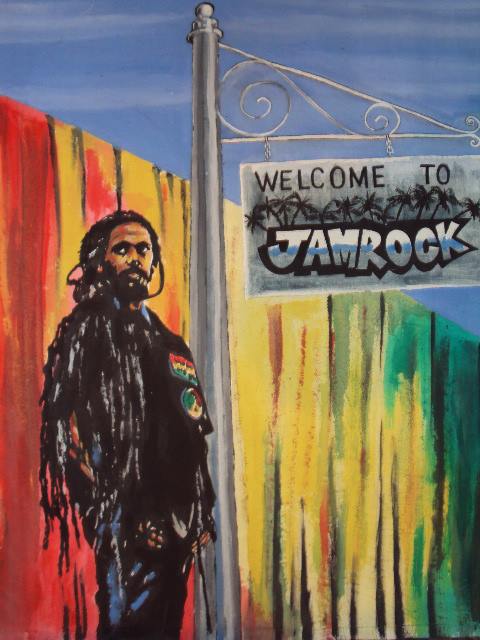By Ogova Ondego
Published February 18, 2015
[showmyads]
 All roads for lovers of culture in Nairobi are likely to lead to Kenya’s House of Culture on Museum Hill. Here, they will be seeking to satiate their curiosity by sampling delicacies from Nairobi National Museum (NNM)’s almost inexhaustible February arts menu.
All roads for lovers of culture in Nairobi are likely to lead to Kenya’s House of Culture on Museum Hill. Here, they will be seeking to satiate their curiosity by sampling delicacies from Nairobi National Museum (NNM)’s almost inexhaustible February arts menu.
To begin with, NNM’s two art shows–Nobody Can Stop Reggae, and The Dolls of Japan: Shapes of Prayer, Embodiments of Love–shall have another joint exhibition opening alongside them on February 20, 2015 followed by a discussion and networking forum on world cultures the following evening.
RELATED: Kenyan Youth Showcase Their Animation, Music and Game Design Skills at Graduation
While the Nobody Can Stop Reggae exhibition by Oliver Martin Okoth has introduced an audio-visual module that enables the art lover to listen to the lyrics and reggae tunes of the works on show, the Dolls of Japan: Shapes of Prayer, Embodiments of Love displays what the organisers call ‘Girls’ Festival’ and ‘Boys’ Day dolls’ and ‘dolls connected to traditional performing arts”, ‘regional dolls’, and ‘creative dolls’.
The exhibition that opens on February 20 features the work of Peterson Kamwathi, Beatrice Wanjiku and Justus Kyalo whom Lydia Gatundu-Galavu, the curator of contemporary art at NNM, describes as “internationally-acclaimed Kenyan artists [who] tend to focus on a minimalist approach right from the roomy negative wall spaces to the simple yet interrogative nature of the individual works.” Each work on display, Gatundu-Galavu says, “is remarkable for its inquisitorial slant on humanity and sensation.”
RELATED: Extraordinary Senegalese Kora Player to Release New Solo Album
 While Beatrice Wanjiku explores the intrinsic nature of human beings to transform and Peterson Kamwathi’s work addresses social, political and environmental issues, Justus Kyalo experiments with colour as a substance, a material, and a tool to provoke emotions.
While Beatrice Wanjiku explores the intrinsic nature of human beings to transform and Peterson Kamwathi’s work addresses social, political and environmental issues, Justus Kyalo experiments with colour as a substance, a material, and a tool to provoke emotions.
And since the teeth can’t effectively litigate in the presence of the tongue, I have to liberally use the language of artist and curator Lydia Gatundu-Galavu to seduce and entice you, the reader, to come to NNM to sample its enticing art. So, here we go: “Transcending throughout the exhibition is a captivating mix of technique and material from mixed media application to manipulation of canvas and sculpture in metal. The visuals are assertive with textured application, abstract forms, stencilled forms, and then realistic albeit miniature forms. The juxtaposition of colour from dark shades to bright hues reflects the threads of our being and feeling.”
But there is still more in store for you.
You—yes, you, the reader—are invited to the Humboldt Forum on Sunday, February 22, 2015, at NNM’s Louis Leakey Auditorium, 4:45 PM – 7:00 PM.
 The Humboldt Forum will be dedicated to the dialogue of the world’s cultures. The discussion is organised within the framework of the official visit of Dr Frank Walter Steinmeier, the German Minister for Foreign Affairs, who is expected to participate in the debate alongside Professor Dr Hermann Parzinger, President of the Prussian Cultural Heritage Foundation, and Professor Dr Klaus-Dieter Lehmann, President of Goethe-Institut.
The Humboldt Forum will be dedicated to the dialogue of the world’s cultures. The discussion is organised within the framework of the official visit of Dr Frank Walter Steinmeier, the German Minister for Foreign Affairs, who is expected to participate in the debate alongside Professor Dr Hermann Parzinger, President of the Prussian Cultural Heritage Foundation, and Professor Dr Klaus-Dieter Lehmann, President of Goethe-Institut.
NNM says “A wider delegation with representatives of the German business and cultural spheres will also be present.”
RELATED: Opportunities for African Artists and Scholars
So, won’t you join in the fun? I, for one, don’t plan to miss out on the action.
According to its website, the “Humboldt Forum sets out to generate a public debate appropriate to the multi-layered relationships between Germany and the rest of the world. Using a wide range of perspectives, rhetorical points of view and narrative forms, it is designed to do justice to the diversity and values of world cultures. For this to work, the key driving forces here are inquisitive curiosity in place of prejudice and clarity in place of ideology.”



